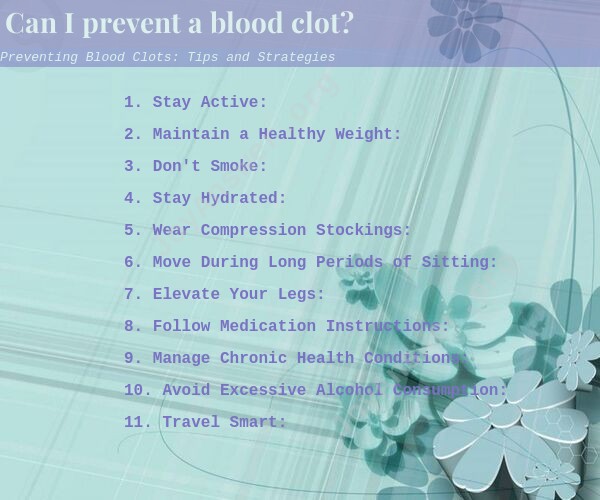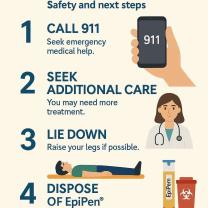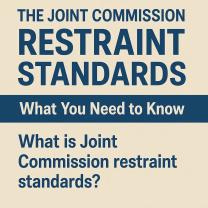Can I prevent a blood clot?
Yes, there are several strategies and lifestyle changes you can adopt to help prevent blood clots. Blood clots can form in your veins (venous thrombosis) or arteries (arterial thrombosis), and they can lead to serious health issues like deep vein thrombosis (DVT), pulmonary embolism, or stroke. Here are some tips and strategies for preventing blood clots:
1. Stay Active:
- Regular physical activity can help improve blood circulation. Simple activities like walking, swimming, or biking can be beneficial.
2. Maintain a Healthy Weight:
- Being overweight or obese can increase the risk of blood clots. Losing excess weight can reduce this risk.
3. Don't Smoke:
- Smoking damages blood vessels and makes blood more likely to clot. Quitting smoking can significantly reduce your risk of blood clots and other health problems.
4. Stay Hydrated:
- Dehydration can lead to thicker blood, which is more prone to clotting. Drink plenty of water to stay well-hydrated.
5. Wear Compression Stockings:
- If you're at risk for DVT or have a history of blood clots, your doctor may recommend wearing compression stockings to improve blood flow in your legs.
6. Move During Long Periods of Sitting:
- If you have a desk job or travel long distances, take breaks to stand, stretch, and walk around to prevent blood from pooling in your legs.
7. Elevate Your Legs:
- Elevating your legs when sitting or lying down can help improve blood flow, especially if you're at risk for leg clots.
8. Follow Medication Instructions:
- If you've been prescribed blood-thinning medications (anticoagulants), take them as directed by your healthcare provider.
9. Manage Chronic Health Conditions:
- Conditions like diabetes, high blood pressure, and high cholesterol can increase clotting risk. Manage these conditions with proper medical care and lifestyle changes.
10. Avoid Excessive Alcohol Consumption:- Excessive alcohol intake can increase the risk of clot formation. Limit your alcohol consumption or avoid it altogether if you're at risk.
11. Travel Smart:- When traveling long distances, especially by plane, try to move around periodically and stay hydrated. Consider wearing compression stockings on long flights.
12. Understand Your Risk Factors:- Know your personal risk factors for blood clots. If you have a family history of clotting disorders or a personal history of blood clots, discuss your risk with a healthcare provider.
13. Birth Control and Hormone Replacement Therapy (HRT):- If you're considering birth control methods or HRT, discuss the potential clotting risks with your healthcare provider. Some birth control methods and hormone therapies can increase clotting risk.
14. Follow Medical Advice After Surgery or Injury:- If you've had surgery or experienced a major injury, follow your healthcare provider's instructions for preventing blood clots, which may include medication or the use of compression devices.
It's important to note that some individuals have genetic factors that predispose them to clotting disorders, which may require more aggressive preventive measures or medication. If you have concerns about your risk of blood clots or need personalized guidance, consult a healthcare professional for a thorough assessment and recommendations tailored to your specific situation.
Guarding Against Blood Clots: Tips to Prevent Their Formation
Blood clots are a serious health condition that can lead to life-threatening complications, such as pulmonary embolism and stroke. However, there are a number of things you can do to prevent blood clots from forming.
Here are some tips:
- Stay active. Regular exercise helps to improve blood flow and circulation. Aim for at least 30 minutes of moderate-intensity exercise most days of the week.
- Maintain a healthy weight. Obesity is a risk factor for blood clots. Losing weight can help to reduce your risk.
- Don't smoke. Smoking damages blood vessels and increases the risk of blood clots.
- Drink plenty of fluids. Dehydration can thicken your blood and make it more likely to clot. Aim to drink eight glasses of water per day.
- Wear loose-fitting clothing. Tight clothing can restrict blood flow and increase the risk of blood clots.
- Avoid prolonged sitting or standing. If you must sit or stand for long periods of time, try to get up and move around every 30 minutes.
Blood Clot Prevention: Strategies to Keep Your Circulation Healthy
In addition to the tips above, there are a number of other strategies you can use to keep your circulation healthy and reduce your risk of blood clots.
These include:
- Eat a healthy diet. A healthy diet can help to improve blood flow and circulation. Eat plenty of fruits, vegetables, and whole grains. Limit your intake of saturated and trans fats, cholesterol, and sodium.
- Manage any underlying medical conditions. Certain medical conditions, such as diabetes, high blood pressure, and high cholesterol, can increase your risk of blood clots. It is important to manage these conditions carefully.
- Take blood thinners if prescribed. If you have a high risk of blood clots, your doctor may prescribe blood thinners. These medications can help to prevent blood clots from forming.
Protecting Your Health: Steps to Reduce the Risk of Blood Clots
If you have a family history of blood clots, or if you have certain medical conditions, such as cancer or pregnancy, you may be at an increased risk of developing blood clots.
Here are some additional steps you can take to protect your health:
- Talk to your doctor about your risk factors. Your doctor can assess your risk of blood clots and recommend ways to reduce your risk.
- Be aware of the signs and symptoms of blood clots. Blood clots can form in any vein in the body, but they are most common in the legs. Symptoms of a blood clot in the leg may include pain, swelling, redness, and warmth. If you experience any of these symptoms, see your doctor immediately.
- Get regular checkups. If you have an increased risk of blood clots, it is important to see your doctor for regular checkups. Your doctor can monitor your risk factors and recommend ways to prevent blood clots.
By following these tips, you can help to protect yourself from the dangers of blood clots.












